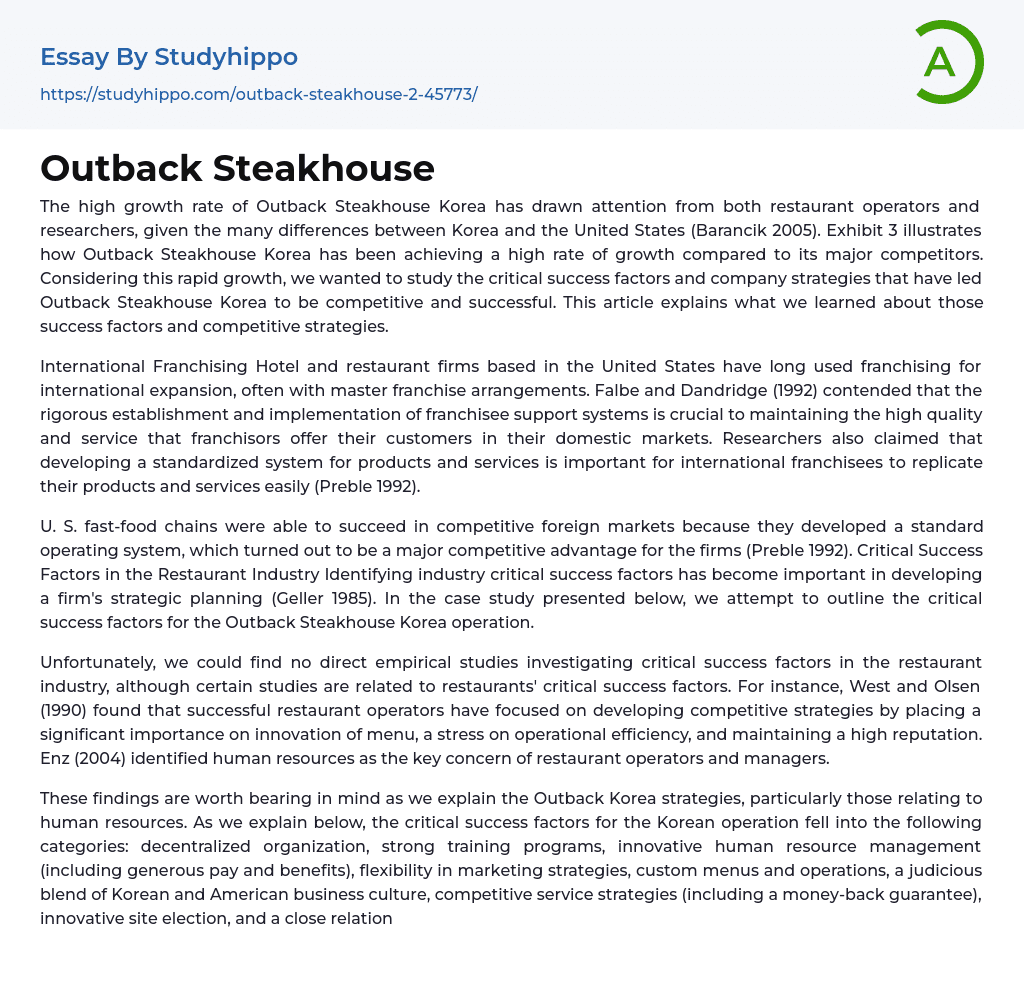The rapid growth of Outback Steakhouse Korea has attracted interest from restaurant operators and researchers due to the contrasting characteristics of Korea and the United States (Barancik 2005). Exhibit 3 displays the notable growth rate of Outback Steakhouse Korea compared to its main rivals. With this impressive growth, we aimed to investigate the essential factors for success and the strategies employed by Outback Steakhouse Korea that have contributed to its competitiveness and achievements. This article elucidates our findings on these success factors and competitive strategies.
International Franchising Hotel and restaurant firms in the United States have long utilized franchising for global expansion, typically through master franchise arrangements. According to Falbe and Dandridge (1992), ensuring the effective development and execution of support systems for franchisees is vital for maintaining the quality and service offered by franchisors in their h
...ome markets. Researchers have also argued that establishing a standardized system for products and services is crucial for international franchisees to efficiently replicate their offerings (Preble 1992).
U.S. fast-food chains found success in competitive foreign markets by implementing a standardized operating system, which proved to be advantageous for the companies (Preble 1992). It has become crucial for restaurants to identify industry critical success factors in order to develop strategic planning (Geller 1985). In the following case study, we aim to outline the critical success factors for Outback Steakhouse Korea's operation.
Despite a lack of direct empirical studies on critical success factors in the restaurant industry, there are relevant studies on this topic. For instance, West and Olsen (1990) discovered that successful restaurant operators prioritize the innovation of their menu, emphasize operational efficiency, and maintain a strong reputation.
Enz (2004) also emphasized the significance of human resources for restaurant operators and managers.
It is important to consider these findings when discussing the strategies of Outback Korea, particularly in relation to human resources. The critical success factors for the Korean operation can be categorized as follows: decentralized organization, strong training programs, innovative human resource management (including generous pay and benefits), flexibility in marketing strategies, custom menus and operations, a blend of Korean and American business culture, competitive service strategies (including a money-back guarantee), innovative site selection, and a close franchisor-franchisee relationship. Customizing service for multicultural markets is a crucial issue for U.S. franchisors. Falbe and Welch (1998) suggest that U.S. franchisors must decide how much they should adopt customization strategies and how to effectively integrate them into the company's standardized operations.
In our case study, we explored how the Outback menu could be modified to attract Korean customers and accounted for any cultural differences that could affect service processes. Stauss and Mang (1999) discovered that cultural differences can influence consumers' service evaluations and appreciation. Tricon restaurant group encountered this issue when implementing its global mystery shopper evaluations.
The executives of the firm dedicated significant time to assessing whether specific service queries, which may be culturally sensitive, could be incorporated (Ghemawat, Khanna, and Shukla 2000). The research method involved a case study approach to thoroughly analyze Outback Steakhouse Korea, a U.S. casual restaurant operating in a culturally diverse global market. This analysis aimed to gain a better understanding of how Outback Steakhouse Korea functions in a competitive and intricate international business environment (Merriam 1998).
The collection of data interviews and document analysis was done using
a triangulation method. This method, known in the case study approach, allows researchers to cross-verify data and increase credibility in the interpretation process (Jick 1979; Stake 1995). Specifically, we conducted interviews with the CEO and a senior managing partner of Outback Steakhouse Korea in Seoul. These interviews utilized a standard open-ended format with pre-prepared questions. The selection and development of these questions were based on previous studies (Preble 1995; Sadi 1994).
The interviews were recorded and transcribed. In addition, various secondary sources such as research papers and technical articles were consulted. Two researchers independently coded the interview transcripts to ensure reliability. The coding scheme used by the research team led to the emergence of themes. A central theme was identified from the transcripts, which formed the basis for the conclusions in this study.
- Cleaning essays
- John Locke essays
- 9/11 essays
- A Good Teacher essays
- A Healthy Diet essays
- A Modest Proposal essays
- A&P essays
- Academic Achievement essays
- Achievement essays
- Achieving goals essays
- Admission essays
- Advantages And Disadvantages Of Internet essays
- Alcoholic drinks essays
- Ammonia essays
- Analytical essays
- Ancient Olympic Games essays
- APA essays
- Arabian Peninsula essays
- Argument essays
- Argumentative essays
- Art essays
- Atlantic Ocean essays
- Auto-ethnography essays
- Autobiography essays
- Ballad essays
- Batman essays
- Binge Eating essays
- Black Power Movement essays
- Blogger essays
- Body Mass Index essays
- Book I Want a Wife essays
- Boycott essays
- Breastfeeding essays
- Bulimia Nervosa essays
- Business essays
- Business Process essays
- Canterbury essays
- Carbonate essays
- Catalina de Erauso essays
- Cause and Effect essays
- Cesar Chavez essays
- Character Analysis essays
- Chemical Compound essays
- Chemical Element essays
- Chemical Substance essays
- Cherokee essays
- Cherry essays
- Childhood Obesity essays
- Chlorine essays
- Classification essays




